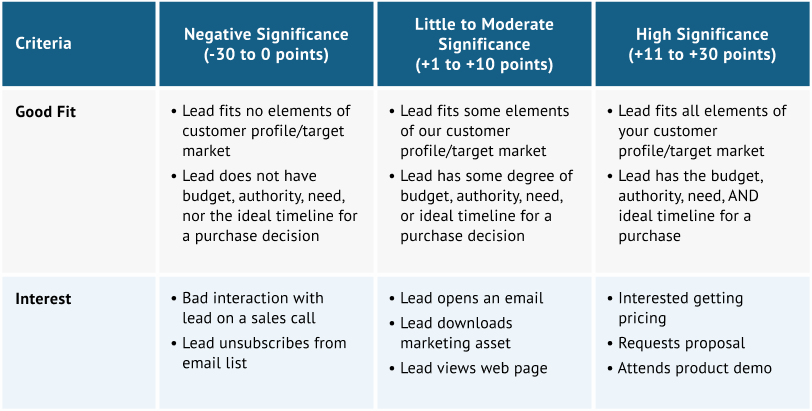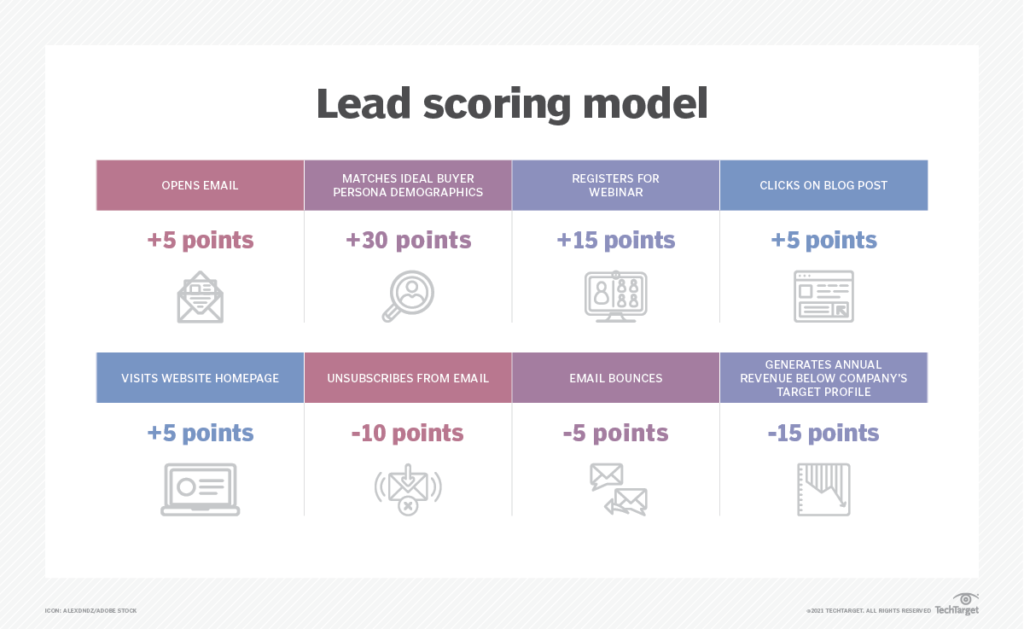Have you ever wondered how businesses identify their most promising customers?
Lead scoring is a strategy that businesses can use to sort and prioritise potential customers. This is done by giving each lead a specific score based on engagement levels, implementation time, and available budget. The higher the score, the more likely a lead is to become a customer.
Businesses can identify their most promising prospects by assigning numerical values to leads and tailoring marketing and sales efforts accordingly. Businesses with effective lead generation processes experience a 133% increase in revenue.
This article will explore the lead-scoring process, the benefits of lead scoring, various lead-scoring email marketing strategies, and how you can build an effective lead-scoring model to grow your business.
What is the lead scoring process?
Lead scoring is a systematic method for evaluating leads based on their characteristics and behaviour. It allows businesses to focus their resources on leads with the highest potential for conversion. However, finding high-quality leads is more than just a scoring method. Instead, it’s an agreement between sales and marketing for defining lead quality, sales follow-up, and cross-departmental collaboration.
Finding the right leads and spending enough time on them is crucial. Spending equal amounts of effort and resources on all leads can be unproductive in the long run. Sales teams may waste time and effort separating valuable leads from unqualified ones. This can lead to inefficiency and cross-departmental tension.
Hence, a well-defined process for scoring and qualifying leads removes subjectivity and introduces an objective approach to where sellers should spend time.
How to build a B2B lead scoring model?
Businesses must determine the attributes and behaviours relevant to their ideal customer profile. This mainly consists of two types of information:
- Demographic information includes job title, industry, company size, and revenue.
- Behavioural data include website visits, email interactions and engagement.
1) Defining lead scoring criteria
Demographic information helps identify whether a lead fits your ideal customer persona. If you’re a B2B company that only sells to organisations of a certain size or industry, demographic information can quickly qualify leads according to your ideal user persona. You can collect this information using forms or social channels like LinkedIn and Crunchbase.
Once you’ve filtered your leads, behavioural data comes into play and is often given more weightage. In today’s information-rich world, qualifying leads based on who they are rather than how they behave is simpler. This is because potential customers often research many products before deciding, while some may just be exploring.
A lead who actively interacts with your website, like filling out forms, downloading resources, or using ROI calculators, will likely be a high-quality lead. Therefore, this type of behavioural data is essential to the lead-scoring process.

2) Assigning weighting
Once you’ve defined the criteria, you must determine their importance by assigning weights. In other words, not all lead criteria are equally important. To prioritise the most significant factors, businesses assign weights to each criterion. This step reflects the relative importance of each attribute in the lead-scoring process.
This can be expressed using points or percentages that add to a total value. To take it further, you can define two different demographic and behavioural qualification scoring systems.
3) Setting Scoring Thresholds
Scoring thresholds are predefined values used to categorise leads into segments, such as “hot,” “warm,” or “cold.” Leads above a certain threshold are considered sales-qualified and ready for handoff to the sales team.
If the bar for entry is too low, leads may be qualified prematurely, causing frustration for sales reps pursuing unprepared prospects. Conversely, if the bar is set too high, there is a risk of delaying valuable leads and giving competitors enough time to seize them. Finding the right balance is essential for businesses to target the right leads at the right time.
To determine the right threshold, analyse historical data and look for characteristics that signify that a lead is qualified.
For instance, if requesting a product demo is the top indicator that a lead will eventually convert into a sale, then the lead scoring threshold should be set in a way that any lead who requests a demo will be assigned enough points to become a Marketing Qualified Lead (MQL) immediately. This helps businesses to prioritise leads and allocate resources to those with the most potential for conversion.
4) Regular feedback loop
An outdated scoring model can easily damage your business. Therefore, establishing a feedback loop with the sales team is crucial. Collecting feedback on lead quality helps refine the scoring model and ensure that it aligns with the evolving needs of the business.
“A good lead score leverages the past to predict the future today”
Liam Boogar-Azoulay, Chief Revenue Officer @ Scaleway
5) Decide how to engage with leads
Scoring is not just about going after the high-score leads. After assigning scores and ratings to leads, defining the appropriate follow-up action is crucial. For example, you can immediately direct high-priority leads to your CRM system for immediate follow-ups or place them in a long-term nurturing program.
Email marketing lead generation and account-based marketing campaigns can target other score ranges. Leads below a certain threshold can be disqualified. Learn more about these actions here.
Benefits of lead scoring
Implementing lead scoring offers a range of benefits that enhance both marketing and sales efforts:
Improves revenue
By prioritising high-quality leads, businesses can increase their revenue potential. According to Marketing Sherpa, companies that use lead scoring mechanisms increase their ROI for lead generation activities by 77%. Another study found that 68% of “highly effective and efficient” marketers attribute their success to lead scoring processes.
High conversion rates
Lead scoring helps sales teams focus on leads with a higher propensity to convert. This targeted approach leads to higher conversion rates, making the sales process more efficient. Once your lead scoring model has matured, you can map conversion rates for different score ranges, allowing you to pour more resources.
Improves marketing campaigns
Like conversion rates, marketers can optimise their campaigns by tailoring content and messages to specific lead segments. This personalised approach produces high-quality leads and more engaging and effective marketing campaigns, which in turn results in more high-quality leads. Eventually, it becomes a perpetual process.
Lead scoring best practices
To make your lead-scoring process even more effective, consider implementing these best practices:
Align Sales and Marketing Teams
Collaboration between sales and marketing teams is essential. Both departments should establish clear lead scoring criteria and regularly communicate to ensure the model remains aligned with business goals.
Marketing and sales departments have distinct roles in lead generation. While marketers focus on optimising the channels that bring in leads, sales teams directly contact leads and can identify new trends, historical patterns, and untapped opportunities.
Define your Ideal Customer Profile (ICP)
Clearly define your ideal customer profile to ensure you’re targeting leads matching your business’s target audience. This reduces wasted resources on unqualified leads.
Depending on your business, you can build multiple personas and develop marketing and sales tactics for each. Evaluate each lead’s authority to make a purchase decision, their spending capabilities, and the urgency for your product or service. The budget, authority, need, and timeline (BANT framework) are great ways to identify prospects and supplement those target customer profiles.
Identify customer touch points
Analyse the various touch points in a lead journey, such as website visits, email opens, and content downloads, and assign scores to gauge lead engagement.
Include negative scoring
Incorporate negative scoring to penalise actions or criteria that indicate disinterest or low quality. For instance, you might reduce a lead’s score if they unsubscribe from your emails.
If a lead is inactive for 20 days, you should be reducing points. This keeps your lead database fresh and relevant.
Set up different scoring models
Consider creating multiple scoring models to cater to different products or services. Not all leads may have the same attributes or behaviours, so tailor your scoring to fit different scenarios. Different lead-scoring models can maintain clarity and effectiveness if you have multiple products that cater to different user segments or industries.

Grow your business with the right lead scoring
To grow your business with lead scoring, you need the right tools. Many organisations struggle with ineffective lead scoring due to poor planning and management. Excel sheets and tables don’t cut it. Utilising tools that specialise in lead scoring is a good option. However, these tools don’t have data and require custom integrations with your historical records.
But with a platform like Vision6, you can tackle this problem. It offers a range of tools, from email and SMS marketing automation to CRM reporting, A/B testing, and more. You can add lead-scoring rules, set weights, and run automated campaigns based on the scores to prioritise and engage with your leads.
For a detailed guide on how the Vision6 platform can help you achieve this, watch this video.





